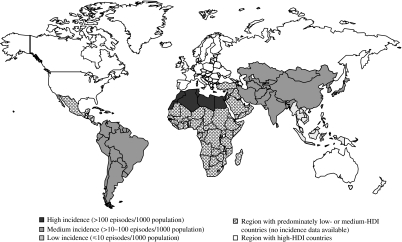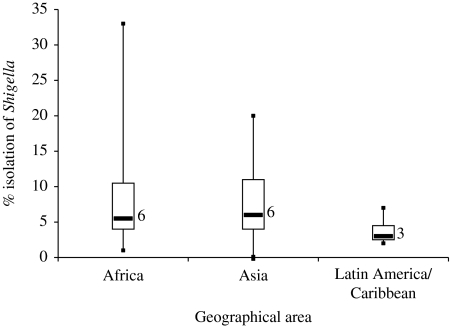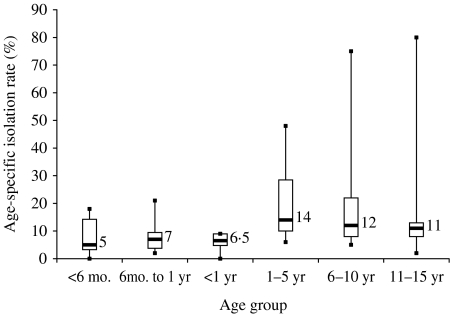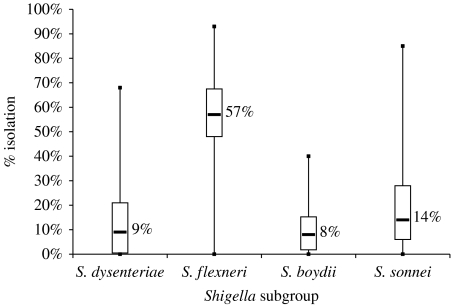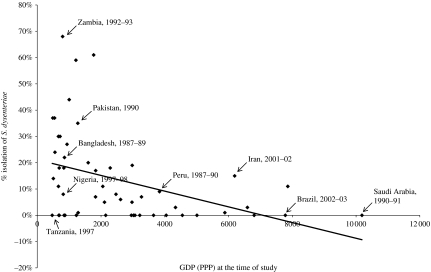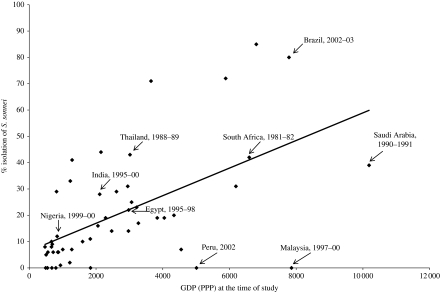SUMMARY
The global incidence of Shigella infection has been estimated at 80–165 million episodes annually, with 99% of episodes occurring in the developing world. To identify contemporary gaps in the understanding of the global epidemiology of shigellosis, we conducted a review of the English-language scientific literature from 1984 to 2005, restricting the search to low and medium human development countries. Our review yielded 11 population-based studies of Shigella burden from seven countries. No population-based studies have been conducted in sub-Saharan Africa or in low human development countries. In studies done in all age groups, Shigella incidence varied from 0·6 to 107 episodes/1000 person-years. S. flexneri was the most commonly detected subgroup in the majority of studies. Case-fatality rates ranged from 0% to 2·6% in population-based studies and from 0% to 21% in facility-based studies. This review highlights the large gaps in data on the burden of Shigella infections for low human development index countries and, more specifically, for sub-Saharan Africa.
INTRODUCTION
The global incidence of Shigella infections has been estimated at 80–165 million episodes annually. An estimated 99% of episodes occur in the developing world and children aged <5 years bear the majority of the burden [1]. Common presenting features of shigellosis can include diarrhoea that is bloody or watery, with or without mucus, fever, abdominal cramps, and tenesmus. The infectious dose, which can be as low as 10 organisms, facilitates person-to-person spread [2].
Members of the family Enterobacteriaceae, the Shigellae are Gram-negative, non-motile, lactose-non-fermenting rods. The four subgroups of Shigellae are S. dysenteriae, S. flexneri, S. boydii, and S. sonnei. S. dysenteriae type 1 produces Shiga toxin, among the most potent toxins known, and can cause large outbreaks of dysentery, particularly in conditions of overcrowding and poor water and hygiene infrastructure [1]. In general, S. sonnei and S. boydii tend to cause milder illness than S. flexneri and S. dysenteriae. Antimicrobial resistance is increasingly found among Shigellae worldwide, with a high prevalence of resistance to first-line drugs such as ampicillin and trimethoprim–sulfamethoxazole [1]. The Integrated Mangement of Childhood Illness strategy recommends ‘the selection of effective first-line and second line antibiotics’ for treating dysentery based on local antimicrobial resistance patterns [3]. Current guidelines from the World Health Organization encourage providers to use ciprofloxacin as first-line therapy for bloody diarrhoea where recent local data on antimicrobial resistance patterns are not available [1].
To identify contemporary gaps in the understanding of the global epidemiology of shigellosis, we conducted a review of the recent scientific literature. We summarize below recent available data on morbidity and mortality burden, the age, geographic and temporal distribution of shigellosis, the isolation of Shigella in context with various other diarrhoeagenic pathogens, and the frequency of the four Shigella subgroups. Because of the relevance to vaccine development, we examine the relative frequency of the numerous serotypes of S. flexneri. In order to provide context to the global epidemiology of shigellosis, we also describe Shigella diagnostics and pathogen-specific preventive measures. Finally, data gaps and existing research needs are discussed.
METHODS
We systematically searched the English-language scientific literature published between 1984 and 2005 using the Medline database, restricting the search to low and medium human development countries according to the United Nations Development Programme's Human Development Index (HDI) (http://hdr.undp.org/2004; accessed 15 January 2007). A set of articles including the relevant epidemiological terms were cross-linked with a set of articles including the relevant pathogen-specific terms (Table 1). The resulting cross-linked set was reviewed for publications addressing Shigella morbidity, mortality, age distribution, geographic distribution, temporal distribution, pathogen-specific preventive measures, and diagnostics. Particularly for morbidity and mortality burden, population-based studies with culture confirmation of cases were considered primary data sources. When these were limited, hospital- and clinic-based studies were included. Publications were then evaluated for their contribution to an understanding of the global epidemiology of shigellosis, and gaps in the data were identified.
Table 1.
Terms used in literature search to identify gaps in data on enteric disease burden
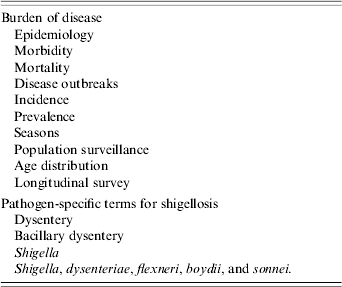
Crude incidence figures are given, without correction for sensitivity of stool culture, or for the proportion of diarrhoeal episodes for which stool specimens were not collected. Publications were sought with information on the incidence of the infection by region according to the 21 regions of the United Nations Department of Social and Economic Affairs, Population Division (http://esa.un.org/unpp/index.asp?panel=5; 2004 revision, accessed 15 January 2007). We examined the correlation between the incidence of Shigella infection and the national per capita gross domestic product (GDP) in year 2000 US dollars, adjusted for purchasing power parity (PPP), at the time that the studies were conducted (http://unstats.un.org/unsd/cdb/cdb_series_xrxx.asp?series_code=29922; accessed 15 January 2007). We searched for publications with information on the age-specific incidence, morbidity, and mortality. We also examined the frequency of Shigella relative to other diarrhoea-causing pathogens including Salmonella, Vibrio cholerae O1, enterotoxigenic Escherichia coli (ETEC), Campylobacter, and rotavirus. In studies that included healthy controls in addition to persons with diarrhoea, we report the frequency of Shigella isolation only among those with diarrhoea. Where stools were tested at two different times of the year, we report data from the period during which a greater number of stool specimens were collected.
RESULTS
Morbidity
Incidence
A 1999 review of published data from 1966 to 1997 estimated the annual global incidence of shigellosis to be approximately 164·7 million episodes, with 163·2 million of those occurring in the developing world [4]. These figures were derived by estimating the total number of diarrhoeal cases and multiplying that by the proportion attributable to shigellosis, as determined by the yield of Shigella in stool culture from persons with diarrhoea. While this review distinguished ‘developing’ countries from ‘industrialized’ countries, few studies were available from sub-Saharan Africa or from low-HDI countries, which contributes to uncertainty regarding the true global incidence of shigellosis.
Our review of the published literature from 1984 to 2005 yielded 11 population-based studies of Shigella burden from seven countries (Table 2) [5, 6, 7–16]. Incidence data were reported in six studies and calculated by one of the authors (P. K. R.) based on data provided for five studies. All 11 studies were conducted in medium-HDI countries; no population-based incidence data were available from low-HDI countries. The geographical distribution of shigellosis has been modelled based on available population-based data (Fig. 1). Studies were conducted in Asia (7), Africa (2), and Latin America (2), with both African studies conducted in Egypt. In this limited group of studies, Shigella incidence did not correlate with national GDP (R=−0·11, P=0·75) (data not shown).
Table 2.
Population-based studies of Shigella incidence published 1984–2005
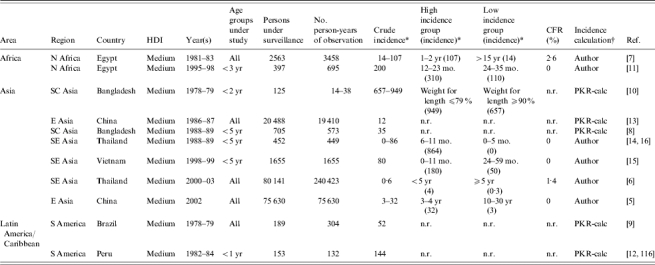
HDI, Human development index; CFR, case-fatality rate; n.r., not reported.
Crude incidence reported as no. cases/1000 persons per year.
Author: incidence reported by author of paper; PKR-calc: incidence calculated by this investigator.
Fig. 1.
Incidence of shigellosis, by geographic region, 1984–2005. Countries contributing incidence data: China [5], Thailand [6], Egypt [7], Bangladesh [8] and Brazil [9].
Among the five studies that included surveillance in all age groups, Shigella incidence varied from 0·6 episodes/1000 person-years in Thailand [6] to 107/1000 person-years in Egypt [7]. In six studies limited to infants and young children, annual incidence ranged from zero cases (Thai children aged <6 months) [14] to 949 cases/1000 person-years (Bangladeshi children aged <24 months with wasting) [10]. Shigella incidence was higher among Egyptian infants aged <6 months (30/1000 child-years) than among infants aged ⩾6 months (23 episodes/1000 child-years) [7]. In contrast, the incidence among Thai children aged 0–5 months was zero, compared to 86 episodes/1000 person years among children aged 6–11 months [14, 16].
Frequency of Shigella relative to other diarrhoeagenic pathogens
Sixty-seven publications reported on the frequency of Shigella and other enteric pathogens in sporadic diarrhoeal illness. Twenty-two studies reported the frequency of Shigella isolation among subjects of all ages (Table 3a), and 45 studies reported on restricted age groups (Table 3b). Data were available from Asia (39 studies), Africa (20), and Latin America (7); one study reported data from four Asian countries [17].
Table 3a.
Relative frequency of endemic Shigella isolation, community- and facility-based studies conducted among all age groups, 1984–2005
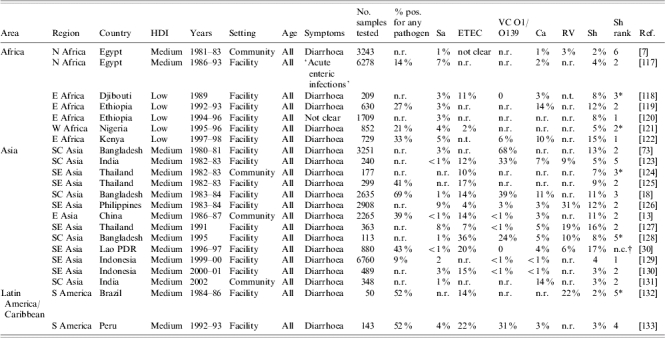
HDI, Human development index; Sa, Salmonella (includes typhoidal and non-typhoidal serotypes); ETEC, enterotoxigenic E. coli; VC, Vibrio cholerae; Ca, Campylobacter; RV, Rotavirus; Sh, Shigella; n.t., not tested; n.r., not reported.
Ranking reported by study author based on identification of other pathogens.
n.c., Ranking not calculable because testing performed on varying number of samples.
Table 3b.
Relative frequency of endemic Shigella isolation, community- and facility-based studies conducted among restricted age groups, 1984–2005
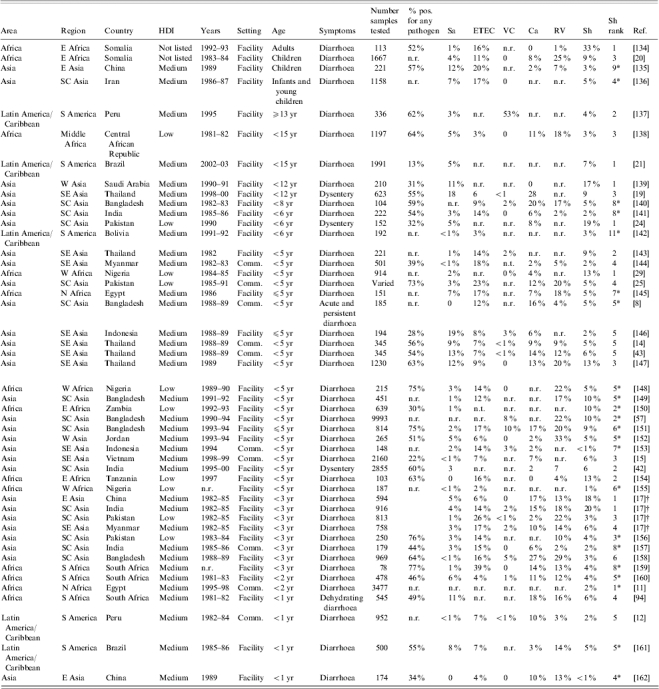
HDI, Human development index; Sa, Salmonella (includes typhoidal and non-typhoidal serotypes); ETEC, enterotoxigenic E. coli; VC, Vibrio cholerae; Ca, Campylobacter; RV, Rotavirus; Sh, Shigella; Comm., community; n.t., not tested; n.r., not reported.
Ranking reported by study author based on identification of other pathogens.
Data from four countries reported in a single publication.
Studies varied widely with respect to specific pathogens tested, and diagnostic techniques used. Often, it was not clear whether a given pathogen was tested for and not detected or whether it was not tested for at all. Notably, the frequency of ETEC isolation was reported by 11 of the 20 studies conducted in Africa, 31 out of 40 Asian studies, and four out of seven studies from Latin America. Rotavirus isolation results were reported in 10 (50%) African, 32 (80%) Asian, and four (57%) Latin American studies. Few investigations reported parasitic aetiologies of diarrhoea.
Shigella was isolated from diarrhoeal or dysenteric stools with similar frequency in Asia and Africa (median isolation rate 6%), and with lower frequency in Latin America and the Caribbean (median 3%) (Fig. 2). Shigella was the first or second most frequently isolated pathogen in 10 studies conducted in Africa (n=20), 15 studies in Asia (n=43), and two studies in Latin America (n=7). Rotavirus was tested for in two of the African studies in which Shigella ranked first or second, in six such studies from Asia, and in none of the studies from Latin America and the Caribbean.
Fig. 2.
Frequency of Shigella isolation in diarrhoeal or dysenteric stools for all age groups, by geographical area, in studies from medium and low human development index (HDI) countries (n=70 studies).
The isolation rate of Shigella from diarrhoea stools was highest among children aged 1–5 years, with isolation among infants aged <6 months relatively similar to isolation among infants aged 6–12 months (Fig. 3) [18–31]. Measles may increase the risk of shigellosis among children, as noted in two papers describing outbreaks of shigellosis following outbreaks of measles [32, 33].
Fig. 3.
Frequency of Shigella isolation in diarrhoeal or dysenteric stools by age group, among children aged <15 years, in studies from medium and low human development index (HDI) countries, 1984–2005 (n=70 studies).
Subgroups
The relative frequency of the four Shigella subgroups in endemic shigellosis was reported by 56 studies (Table 4a). Studies reporting subgroups of fewer than five Shigella isolates were excluded. The median rate of isolation of S. flexneri, S. dysenteriae, S. boydii, and S. sonnei were 57%, 10%, 8%, and 17%, respectively (Fig. 4). S. flexneri was the most commonly detected subgroup in 48 studies and S. dysenteriae was most common in four studies.
Table 4a.
Frequency of Shigella subgroups in endemic disease, 1984–2005
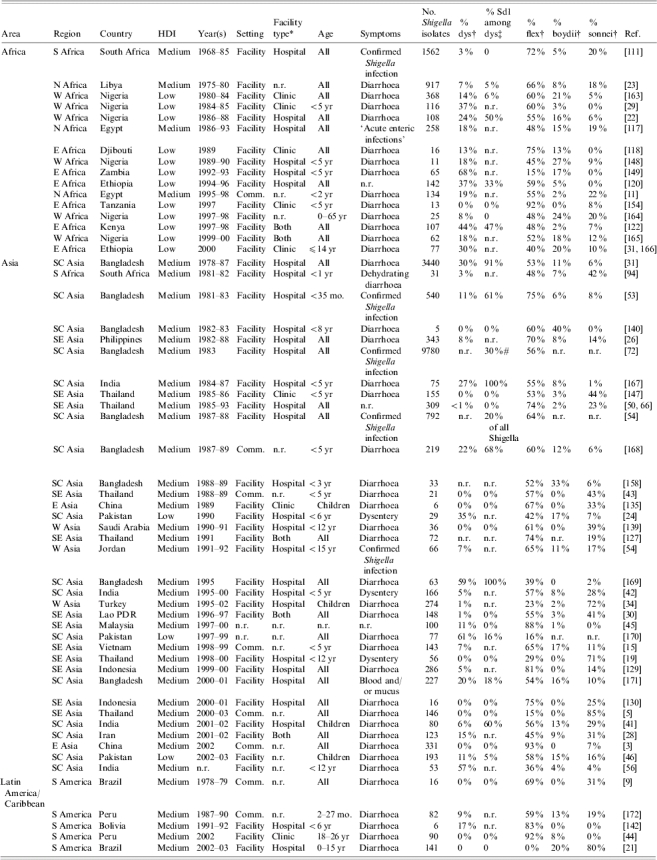
HDI, Human development index; n.r., not reported; Comm., community.
Facility type: ‘both’ refers to patient recruitment in both hospital and clinic.
% dys (S. dysenteriae), % flex (S. flexneri), % boydii, and % sonnei reflect the proportion of the total number of Shigella isolates.
% Sd1 among dys: Sd1 data is presented as % of total Sd1, except where indicated by #, in which case % Sd1 reflects % of all Shigella.
Fig. 4.
Frequency of Shigella subgroups detected among Shigella isolates from medium and low human development index (HDI) countries, 1984–2005 (n=56 studies).
The frequency of S. dysenteriae isolation was inversely correlated with per capita GDP (Fig. 5) (R=−0·54, P<0·0001), and the frequency of S. sonnei isolation was directly correlated with per capita GDP at the time of the study (Fig. 6) (R=0·55, P<0·0001). S. sonnei was the most frequently isolated subgroup in two studies from Thailand published in 2002 and 2005, one from Brazil published in 2005, and one from Turkey published in 2005 [6, 19, 21, 34].
Fig. 5.
Frequency of S. dysenteriae among Shigella isolates, by per capita gross domestic product (GDP) (adjusted for purchasing power parity, PPP) of medium and low human development index (HDI) countries, 1984–2005 (n=56 studies) (R=−0·54, P<0·0001). The names of study countries and the years of study are indicated for selected studies.
Fig. 6.
Frequency of S. sonnei among Shigella isolates, by per capita gross domestic product (GDP) (adjusted for purchasing power parity, PPP) of medium and low human development index (HDI) countries, 1984–2005 (n=56 studies) (R=0·55, P<0·0001). The names of study countries and the years of study are indicated for selected studies.
None of the population-based studies provide age-specific incidence of Shigella subgroups or serotypes. Among studies reporting isolation rates, three provide data on age-specific isolation of Shigella subgroups [26, 28, 31]. In Bangladesh, S. flexneri was the most frequently isolated subgroup among all age groups except for the 5–9 years group, among whom S. dysenteriae type 1 was more common [31]. In every age group studied in the Philippines, S. flexneri accounted for at least 75% of Shigella infections including 75% among the 1–2 years age group and 88% among those aged 10–14 years [26]. Based on only 123 total isolates from Iran, S. flexneri was most common among children aged 1–5 years and persons aged ⩾12 years; S. sonnei was most common among children aged <1 year and was as frequent as S. flexneri among children aged 5–12 years [28].
Fourteen studies assessed the relative frequency of Shigella subgroups during epidemics; 11 focused on persons with dysentery (variably defined as blood with or without mucus in stools) (Table 4b). None of these studies were conducted in Latin America and the Caribbean. Twelve identified a predominance of S. dysenteriae infections, specifically serotype 1, and two identified a predominance of S. flexneri infections.
Table 4b.
Frequency of Shigella subgroups in epidemic context, 1984–2005

HDI, Human development index; n.r., not reported.
Facility type: ‘both’ refers to patient recruitment in both hospital and clinic.
% dys (S. dysenteriae), % flex (S. flexneri), % boydii, and % sonnei reflect the proportion of the total number of Shigella isolates.
%Sd1 among dys: Sd1 data is presented as % of total Sd1, except where indicated by #, in which case % Sd1 reflects % of all Shigella.
Serotypes
S. dysenteriae is comprised of 15 serotypes, of which type 1 has the capacity to cause large outbreaks [1]. Between 2002 and 2004, numerous publications documented circulating S. dysenteriae type 1 strains resistant to commonly used fluoroquinolones, including ciprofloxacin and ofloxacin [35–41]. The organism remained susceptible only to azithromycin, pivmecillinam, and third-generation cephalosporins.
The World Health Organization (WHO) Collaborating Centre for Shigella at the Centers for Disease Control and Prevention recognizes six serotypes of S. flexneri, which can be further classified into numerous subserotypes, as well as S. flexneri X and Y. Thirteen studies (eight published after 2000), report S. flexneri serotypes in endemic shigellosis (Table 5). Serotype 2a was the most commonly detected serotype in four studies, accounting for 35–67% of S. flexneri isolates; all four studies were conducted in Asia [6, 19, 42, 43]. Serotype 1a was the most frequently isolated in a population-based study in China [5]. Serotype 1b was the most frequently detected serotype in Malaysia and the Peruvian Amazon [44, 45]. Subserotype 3c was reported from Malaysia and Pakistan, with reports of serotypes 7, 8, and 10 from Pakistan as well [45, 46]. Subserotype 1c has also been reported from Bangladesh and Egypt [47, 48].
Table 5.
Frequency of S. flexneri serotypes in endemic setting, 1984–2005

Number of S. flexneri isolates for which serotype data is provided exceeds number of S. flexneri reportedly isolated in study.
Complications
Few complications were reported in population-based studies of Shigella infection. Dehydration was reported in 11% and 16% of patients [11, 12]. Wang et al. reported no cases of rectal prolapse or other gastrointestinal complications in China [5]. Shigella diarrhoea was associated with decreased linear growth rates in a study by Black and colleagues, with the per cent of days of Shigella diarrhoea negatively correlated with linear growth [49]. Two studies reported a prolonged duration of diarrhoea with S. flexneri infection compared to infection with other Shigella subgroups [5, 6].
Facility-based studies of shigellosis, albeit probably skewed towards very ill patients and those who can access health-care services, provide additional insight. The rate of hospitalization has ranged from 11% to 47% [44, 50–53]. Dehydration was documented in 2–70% of patients [52, 54–56]. Gastrointestinal complications of Shigella infection include persistent diarrhoea (7–38%) [56–59], intestinal obstruction (3–5%) [56, 60], rectal prolapse (3–38%) [56, 58], and protein-losing enteropathy (3%) [61]. The risk of persistent diarrhoea following Shigella infection appears to be increased among young children, in dysenteric episodes of confirmed shigellosis, following infections caused by multiply-resistant Shigellae, or when nalidixic acid (NAL) is administered for infections caused by NAL-resistant organisms [59]. Intestinal perforation was reported anecdotally in one study [62].
Haemolytic–uraemic syndrome (HUS), was diagnosed in 1–24% of persons hospitalized with S. dysenteriae type 1 [58, 61, 63]. In Bangladesh, HUS was diagnosed in 27% of Shigella-confirmed patients with intestinal obstruction, and none without obstruction [60]. Three studies reported treatment with antimicrobial agents to which the pathogen is resistant as a risk factor for HUS [63–65]. Acute renal failure was documented in 1% [58] and 25% [56] of hospitalized patients; neither study specified the proportion of renal failure cases occurring in the context of HUS. Electrolyte imbalances were documented in 42% of patients; both hyponatraemia and hyperkalaemia have been reported [50, 56].
Central nervous system (CNS) manifestations of Shigella infection were noted in 45% of patients in one series [50]. This, and other studies describe complications including seizures (5–27%) [50, 54, 66] and loss of consciousness (10%) [50, 56]. Factors significantly associated with CNS manifestations include age <15 years, electrolyte imbalance, severe dehydration, fever, shorter duration of illness, higher median weight-for-age, and increased immature leukocytes [50].
Although a recognized complication, this literature search yielded only three reports of reactive arthritis as sequelae to S. flexneri infections [64, 65, 67]. Bacteraemia is a relatively rare complication and young age is an important risk factor [68]. Among the handful of adult patients reported to have Shigella bacteraemia, immunocompromising conditions, such as HIV/AIDS are common. One case report from the United States documented recurrent infection with S. boydii in an HIV-infected patient despite 10 days of ceftriaxone therapy, suggesting the need for prolonged therapy in persons with HIV/AIDS and Shigella bacteraemia [69].
Poor nutritional status appears to increase the risk of shigellosis associated with fever, severe dehydration, severe neurological manifestations such as seizures or coma, or requiring hospitalization [53, 57, 70].
Mortality
Only six population-based studies of Shigella incidence included case-fatality rates (CFR) (Table 2). These ranged from 0% [5, 11, 14] to 2·6% (Egypt) [6, 7]. In facility-based studies that reported deaths of hospitalized patients with culture-confirmed endemic Shigella infection, CFRs ranged from 0% to 21% (Table 6).
Table 6.
Case-fatality rates in hospital-based studies of endemic shigellosis, 1984–2005
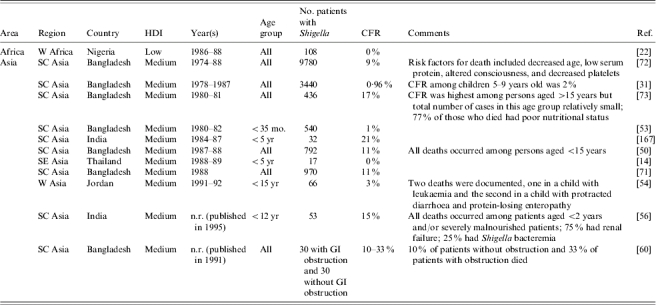
HDI, Human development index; CFR, Case-fatality rate; n.r., not reported; GI, gastrointestinal.
In one study from Bangladesh, patients with shigellosis who were discharged from the hospital (CFR 5%) had a significantly higher risk of post-hospitalization death than persons with watery diarrhoea (CFR 3%) [71]. Reported risk factors for death include young age [31, 50, 56, 72], poor nutritional status [56, 72, 73], and CNS manifestations such as altered consciousness or seizures [50, 72]. In a series from North India, 75% of patients who died had renal failure and 25% had Shigella bacteraemia [56]. Notably, none of these hospital-based studies specifically reported HUS as a risk factor for death. Among severely malnourished children with S. dysenteriae type 1 and S. flexneri, risk factors for death included hypothermia, altered consciousness, low serum blood glucose, and pneumonia [74].
A total of 21 studies, all from Africa or Asia, report CFRs of 0% [36, 75] to 40% [76] (median 4%) for epidemic S. dysenteriae type 1 (Table 7). In large epidemics, S. dysenteriae type 1 can account for 0·25–40% of all-cause mortality [51, 77, 78]. Young children are at increased risk of death from epidemic S. dysenteriae type 1 [33, 51, 61, 78–83]. Additional risk factors include CNS complications [38], malnutrition [61], the constellation of symptoms and signs associated with HUS [58, 84], intestinal perforation [84], and treatment with antimicrobial agents to which the pathogen is resistant [76].
Table 7.
Case-fatality rates in epidemic S. dysenteriae type 1, 1984–2005
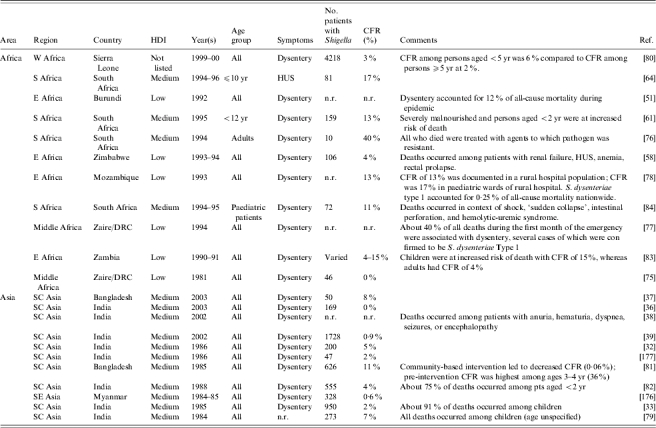
HDI, Human development index; CFR, Case-fatality rate; HUS, haemolytic–uraemic syndrome; n.r., not reported.
Temporal distribution
Among 32 studies reporting on seasonal distribution of Shigella infection, 10 were conducted over a period of ⩽1 year and four studies were conducted over a period of ⩾1 year and <2 years. A total of 17 studies were conducted over ⩾2 years, among which seasonality was reported using a variety of terms, including the specific months of the year, the quarters of the year, or more vague terms such as ‘rainy season’ and ‘dry season’. No clear patterns emerged, even when studies were segregated according to northern or southern hemisphere (data not shown).
Pathogen-specific preventive measures
A 2004 review summarizes the current status of Shigella vaccines [85]. Immunity to Shigella infection, which is directed against the O antigen, is type-specific. Four candidate vaccines using oral formulations (SC 602, CVD 1203, CVD 1204, CVD 1208) and one candidate using the parenteral route (S. flexneri 2a LPS conjugated to recombinant Pseudomonas exoprotein A) target S. flexneri 2a. One oral (WRSS1) and one parenteral vaccine (S. sonnei LPS conjugated to Pseudomonas exoprotein A) target S. sonnei.
Poor toilet and hand hygiene practices play an important role in facilitating Shigella transmission in industrialized and developing countries. Shigellae are also effectively transmitted through contaminated water and survival in water appears to vary by subgroup: S. dysenteriae (2–3 days), S. flexneri (6–47 days), and S. sonnei (35–39 days) [83, 86–89]. Foods, particularly contaminated produce, are well-recognized as vehicles for Shigella transmission [52, 83, 90]. Flies have been implicated and may be especially important in settings where latrines are in close proximity to food preparation or consumption areas [91–94]. Promotion of handwashing with soap has been linked to reduced Shigella transmission in endemic and epidemic settings [95, 96]. Specific latrine behaviour may be important. Anal cleansing rags used communally were implicated in one outbreak of S. dysenteriae type 1 [51]. To the extent that the use of toilet paper reduces hand contamination with stool, this simple intervention may also be useful for reducing Shigella transmission [97]. Notably, one study has demonstrated dramatic reductions in Shigella incidence with aggressive measures to control houseflies, which may breed in latrines [92].
Diagnostics
Culture of whole stools or stool collected by rectal swab is the most widely used technique for diagnosis of Shigella infection. However, Shigellae are relatively fragile organisms compared with other enteric pathogens. Yield from stool culture is increased when the specimen is placed in transport medium and held at refrigeration temperatures (4°C) if not cultured immediately [98]. Buffered glycerol saline is the preferred medium but Cary–Blair medium is also acceptable. Polymerase chain reaction (PCR) techniques have been used to identify Shigella genes coding for the invasion plasmid antigen H (ipaH), which is present in all Shigellae and in enteroinvasive E. coli, and Shiga toxin (stx), which is present in S. dysenteriae type 1 and in enterohaemorrhagic E. coli. When compared with PCR testing for Shigella primers, the sensitivity of culture has been estimated at 72% [99].
Recent data suggest that an innovative transport technique (DNA/RNA Protect™, Sierra Diagnostics Inc., Sonora, CA, USA) permits detection of ipaH from stool specimens held for prolonged periods at room temperature [100]. An enzyme-linked immunosorbent assay (ELISA) is available for detection of Shiga toxin 1. The ELISA was evaluated in a single study in Bangladesh, and demonstrated 95% sensitivity and 85% specificity for detection of S. dysenteriae type 1 [101].
DISCUSSION
This review highlights the large gaps in data on the burden of Shigella infections for low-HDI countries and, more specifically, for sub-Saharan Africa (Table 8). It also identifies additional research needed with respect to the burden of disease among infants and population-based rates of Shigella-associated complications and mortality. Comprehensive microbiological, clinical, and epidemiological studies using newer and more sensitive diagnostic methods to determine the relative importance of Shigella and other diarrhoeal pathogens could help address these data gaps and further inform prevention efforts.
Table 8.
Data gaps and research needs for Shigella infections in medium and low human development index (HDI) countries
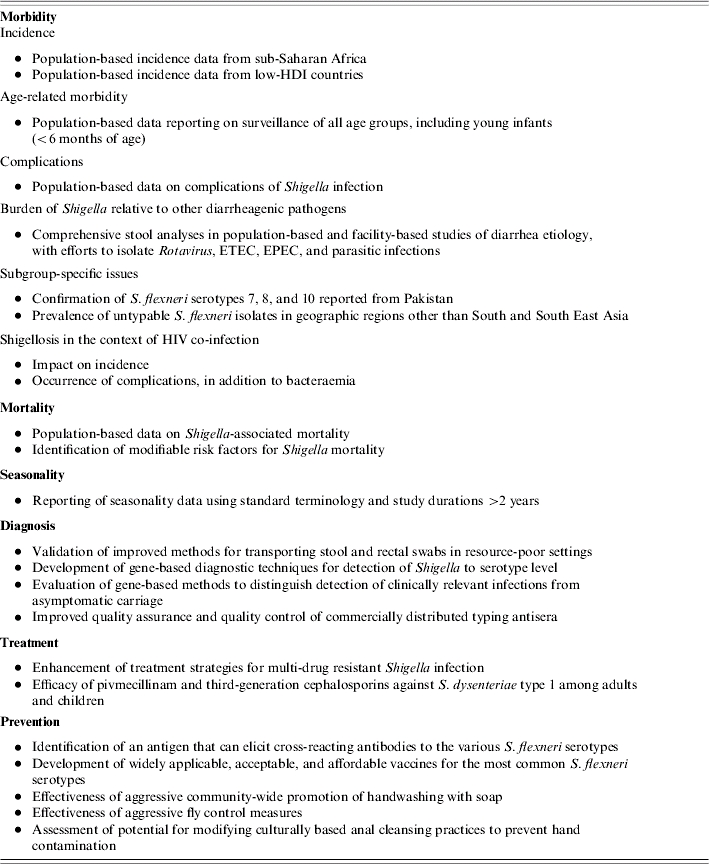
The absence of population-based incidence data from sub-Saharan Africa and from low-HDI countries is our most striking finding. Because of their low development status, and limited access to improved water supplies and sanitation facilities, these countries may be expected to have a higher burden of Shigella infections than the medium-HDI countries where population-based studies have been conducted. Moreover, given the additional lack of substantial data on shigellosis in the context of HIV disease, active population-based surveillance studies conducted in this important geographic region to elucidate overall disease burden, frequency of subgroups, serotypes, and subserotypes, are critical for understanding the true global burden of Shigella infections.
This review detected wide variation in the incidence of Shigella infections from the few available population-based studies, ranging from 0 episodes/1000 person-years [14] to 949 episodes/1000 person-years [10]. However, comparisons between these studies is challenging because of variations in the age groups under study, methodologies for surveillance, and techniques for specimen collection, transport, and culture.
Several population-based studies included only young children; others, which included all age groups, reported incidence data only by age group and not for the population as a whole. Where possible, future population-based studies should describe age group-specific and total incidence, and include isolation rates for all Shigella and for the specific subgroups and serotypes.
The risk of shigellosis among young infants is poorly characterized. This review identified very few studies that separated out infants aged <6 months who are likely to be breastfeeding and, thus, exposed to maternal IgA [102]. Population-based data on the incidence of Shigella infections among infants aged <6 months and 6–11 months could help inform this discussion, which is critical to the development and deployment of Shigella vaccines.
Our attempts to estimate the frequency of Shigella relative to other diarrhoeal pathogens revealed important variations in the spectrum of pathogens sought. Rotavirus, the most common cause of severe diarrhoeal illness worldwide [103], was not tested for in a majority of the ten African studies that found Shigella to be the first or second leading cause of diarrhoea. This review underscores the need for comprehensive stool analyses, including identification of Rotavirus, the different groups of diarrhoeagenic E. coli, and parasitic infections, in aetiological studies of diarrhoeal disease. Moreover, such studies are particularly needed in sub-Saharan Africa.
A vast amount of data has been published between 1984 and 2005 regarding the relative frequency of the four Shigella subgroups. The predominance of S. flexneri above other subgroups, particularly in endemic shigellosis, is clear. S. sonnei remains the most frequently isolated subgroup in industrialized countries [4]. Even among medium- and low-HDI countries, there is a significant correlation between the GDP of the country at the time of the study and the frequency of S. sonnei isolation. The predominance of S. sonnei over S. flexneri in recent studies from Thailand, Brazil, and Turkey probably reflects the expanding economies in these three countries.
Given their respective importance to epidemics and frequency of isolation, we focused this review on S. dysenteriae serotype 1 and on the serotypes of S. flexneri. Large epidemics of S. dysenteriae type 1 were documented in Central America in the 1960s and 1970s, across Africa during the 1980s and 1990s and in South Asia during the early part of each decade between 1970 and the present [104–106]. Studies reporting on the frequency of Shigella subgroups in the epidemic context indicate that during an epidemic period, a single subgroup, particularly S. dysenteriae serotype 1, can explain the majority of Shigella infections [77]. With each reemergence, S. dysenteriae type 1 has exhibited an expanding resistance profile. Most recently, strains of S. dysenteriae type 1 circulating in South Asia have demonstrated resistance to multiple fluoroquinolones, with susceptibility only to azithromycin, pivmecillinam and third-generation cephalosporins [35–42 35–42, 105]. Studies of the efficacy of these agents against S. dysenteriae type 1 are rare and have only been conducted in adults [107, 108]. It is vital to better characterize effective antimicrobial agents and regimens for the treatment of multiply-resistant S. dysenteriae type 1 infection in children and adults ahead of the next epidemic. Indeed, multi-drug resistance (MDR) is a common feature of the other Shigella subgroups as well. Identifying the best therapeutic strategies for MDR Shigella remains a central research priority in the study of shigellosis.
Information on the subserotypes of S. flexneri is relevant because of the implications for vaccine development; most recent studies identified in this review provided that information. Currently, subserotypes 1c and 3c, and serotypes 7, 8, and 10, are not recognized by the WHO Collaborating Centre for Shigella at the Centers for Disease Control and Prevention (CDC). The International Committee on Systematic Bacteriology Subcommittee on the Taxonomy of Enterobacteriaceae recognized only two subserotypes within S. flexneri serotype 1 (1a and 1b) and serotype 3 (3a and 3b) in 1984 [109]. It is important to confirm the identification of serotypes 7, 8, and 10 reported from Pakistan and to assess their contribution to S. flexneri disease elsewhere.
A large number (18%) of untypable S. flexneri isolates was reported from Pakistan, a finding also noted in studies from Vietnam and Bangladesh, in which 40% and 12% of S. flexneri, respectively, could not be definitively serotyped [15, 46, 110]. Several studies reported the serotype of <100% of S. flexneri infections [6, 23, 44, 111], suggesting that some isolates could not be definitively serotyped. The prevalence of untypable S. flexneri isolates in geographical regions other than South and South East Asia, and the implications of these findings for vaccine development demand further study.
Reliable typing antisera for S. flexneri are not easily produced because of the need to absorb cross-reacting antibodies. In the past, quality assurance and quality control problems have been noted in commercially available typing antisera [112]. Improved quality assurance and quality control of commercially distributed typing antisera is necessary to better define the epidemiology of S. flexneri.
The literature search strategy yielded many reports about the complications of Shigella infection; however, most of these were from hospital-based studies that are biased towards the most severely ill patients with shigellosis. An important gap in the literature is the absence of population-based rates of Shigella complications. Such surveillance may require longer-term follow-up of larger populations than most demographic surveillance systems currently conduct.
Our review yielded Shigella mortality data from six population-based studies. None of the five population-based studies conducted before 1990 provided mortality information. Calculation of mortality rates in population-based studies are critical for estimating the true public health impact of shigellosis; however, such studies are rightfully conducted under strict human subjects research guidelines, mandating prompt and appropriate treatment for bloody diarrhoea. Thus, it is difficult to study the natural history of Shigella complications or mortality in such a research setting. Although unbiased estimates of Shigella mortality may be difficult to obtain, the consistent use of verbal autopsy data and molecular diagnostic techniques in population-based surveillance may help. Risk factors for death in endemic shigellosis were available only from papers from South Central Asia and from one study in Jordan. Identification of modifiable risk factors for death from all regions and strategies for prevention of these risk factors are important needs in the study of Shigella.
Despite a number of studies reporting on the temporal distribution of Shigella infections, no clear patterns emerged with respect to seasonality. The use of non-standard terminology and data collection for <2 consecutive years make comparisons of seasonal trends across studies difficult. We recommend the collection and analysis of temporal distribution data for shigellosis over multi-year periods, using consistent descriptors and contextual environmental information such as rainfall and flooding.
Since Shigellae, like many other enteric pathogens, are transmitted through consumption of contaminated food and drinking water, improvements in sanitation, drinking water quality, and food preparation and storage practices in homes and in communities are expected to have dramatic impacts on the burden of shigellosis. Because the pathogen has a low infectious dose, the promotion of handwashing with soap after defecation would be expected to reduce the risk of Shigella transmission [1]. However, specific data regarding the beneficial effects and feasibility of scaling up of household-level control measures, such as promotion of handwashing with soap, improved latrine design to include handwashing stations, aggressive fly control, and modification of culturally ingrained anal cleansing habits are largely lacking.
A number of candidate Shigella vaccines are under development. Oral formulations would probably be most useful for the developing world. In September 2006, the International Vaccine Institute, with partners in various Asian countries, estimated the burden of Shigella infections and identified the frequency of subgroups and serotypes. Their work demonstrates that 90% of S. flexneri infections are caused by eight different serotypes and subserotypes [113, 114]. This diversity suggests that the identification of an antigen common to most or all of the S. flexneri serotypes would facilitate vaccine development significantly. While extensive attention has been paid to the development of Shigella vaccines, and data has been gathered regarding Shigella burden in Asia, relatively little information is available regarding the epidemiology of shigellosis and, importantly, the feasibility of introducing these vaccines in sub-Saharan Africa.
Finally, any estimation of the burden of Shigella infections must take into account the limitations of currently utilized specimen transport and diagnostic methods [98]. Thus, even the culture-based estimates of Shigella incidence reported above may underestimate the true burden of disease. Improved transport methods, such as the DNA/RNA Protect™ specimen collection system, must be validated for the detection of Shigella in clinical settings, especially in remote areas. Population-based surveillance for Shigella incidence using potentially more sensitive methods, such as PCR techniques, in addition to culture, may improve Shigella incidence estimates [115]. Moreover, development and evaluation of rapid gene-based diagnostic techniques for faecal specimen testing, available to the serotype level, may enhance measurement of the burden of Shigella and its various serotypes. However, given their potential for high sensitivity, these methods should be evaluated to understand the extent to which they detect clinically relevant infections vs. asymptomatic carriage.
In summary, this paper describes the acute need for population-based studies of Shigella morbidity and mortality from sub-Saharan Africa, and from low-HDI countries in general. Such information would be invaluable for the prioritization of precious public health resources for pathogen-specific interventions, such as vaccination programmes targeting Shigella. Additional data regarding complications, modifiable risk factors for mortality, the burden of disease among infants, effectiveness of non-vaccine prevention measures, and improved diagnostics would add greatly to our knowledge of Shigella infections.
ACKNOWLEDGEMENTS
This work was supported in part by the U.S. National Institutes of Health Fogarty International Center and by grant number 32143 from the Bill and Melinda Gates Foundation ‘Assessment of diarrhea disease burden and public health programs to control diarrhea in Asian subcontinent and Africa’.
DECLARATION OF INTEREST
None.
REFERENCES
- 1.WHO. Guidelines for the Control of Shigellosis, including Epidemics due to Shigella dysenteriae 1. Geneva, Switzerland: World Health Organization; 2005. [Google Scholar]
- 2.DuPont HL et al. Inoculum size in shigellosis and implications for expected mode of transmission. Journal of Infectious Diseases. 1989;159:1126–1128. doi: 10.1093/infdis/159.6.1126. [DOI] [PubMed] [Google Scholar]
- 3.WHO. Model Chapter for Textbooks: IMCI Integrated Management of Childhood Illness. UNICEF; Geneva: WHO; 2001. [Google Scholar]
- 4.Kotloff KL et al. Global burden of Shigella infections: implications for vaccine development and implementation of control strategies. Bulletin of the World Health Organization. 1999;77:651–666. [PMC free article] [PubMed] [Google Scholar]
- 5.Wang XY et al. Occurrence of shigellosis in the young and elderly in rural China: results of a 12-month population-based surveillance study. American Journal of Tropical Medicine & Hygiene. 2005;73:416–422. [PubMed] [Google Scholar]
- 6.Chompook P et al. Estimating the burden of shigellosis in Thailand: 36-month population-based surveillance study. Bulletin of the World Health Organization. 2005;83:739–746. [PMC free article] [PubMed] [Google Scholar]
- 7.Zaki AM et al. The detection of enteropathogens in acute diarrhea in a family cohort population in rural Egypt. American Journal of Tropical Medicine & Hygiene. 1986;35:1013–1022. doi: 10.4269/ajtmh.1986.35.1013. [DOI] [PubMed] [Google Scholar]
- 8.Baqui AH et al. Enteropathogens associated with acute and persistent diarrhea in Bangladeshi children less than 5 years of age. Journal of Infectious Diseases. 1992;166:792–796. doi: 10.1093/infdis/166.4.792. [DOI] [PubMed] [Google Scholar]
- 9.Giugliano LG et al. Longitudinal study of diarrhoeal disease in a peri-urban community in Manaus (Amazon-Brazil) Annals of Tropical Medicine & Parasitology. 1986;80:443–450. doi: 10.1080/00034983.1986.11812045. [DOI] [PubMed] [Google Scholar]
- 10.Black RE et al. Malnutrition is a determining factor in diarrheal duration, but not incidence, among young children in a longitudinal study in rural Bangladesh. American Journal of Clinical Nutrition. 1984;39:87–94. doi: 10.1093/ajcn/39.1.87. [DOI] [PubMed] [Google Scholar]
- 11.Abu-Elyazeed RR et al. Epidemiology of Shigella-associated diarrhea in rural Egyptian children. American Journal of Tropical Medicine & Hygiene. 2004;71:367–372. [PubMed] [Google Scholar]
- 12.Black RE et al. Incidence and etiology of infantile diarrhea and major routes of transmission in Huascar, Peru. American Journal of Epidemiology. 1989;129:785–799. doi: 10.1093/oxfordjournals.aje.a115193. [DOI] [PubMed] [Google Scholar]
- 13.Chen KC et al. The epidemiology of diarrhoeal diseases in southeastern China. Journal of Diarrhoeal Diseases Research. 1991;9:94–99. [PubMed] [Google Scholar]
- 14.Punyaratabandhu P et al. Childhood diarrhoea in a low-income urban community in Bangkok: incidence, clinical features, and child caretaker's behaviours. Journal of Diarrhoeal Diseases Research. 1991;9:244–249. [PubMed] [Google Scholar]
- 15.Isenbarger DW et al. Prospective study of the incidence of diarrhoea and prevalence of bacterial pathogens in a cohort of Vietnamese children along the Red River. Epidemiology & Infection. 2001;127:229–236. doi: 10.1017/s0950268801005933. [DOI] [PMC free article] [PubMed] [Google Scholar]
- 16.Lee H et al. Shigellosis remains an important problem in children less than 5 years of age in Thailand. Epidemiology & Infection. 2005;133:469–474. doi: 10.1017/s0950268804003590. [DOI] [PMC free article] [PubMed] [Google Scholar]
- 17.Huilan S et al. Etiology of acute diarrhoea among children in developing countries: a multicentre study in five countries. Bulletin of the World Health Organization. 1991;69:549–555. [PMC free article] [PubMed] [Google Scholar]
- 18.Baqui AH et al. Surveillance of patients attending a rural diarrhoea treatment centre in Bangladesh. Tropical & Geographical Medicine. 1991;43:17–22. [PubMed] [Google Scholar]
- 19.Bodhidatta L et al. Bacterial enteric pathogens in children with acute dysentery in Thailand: increasing importance of quinolone-resistant Campylobacter. Southeast Asian Journal of Tropical Medicine & Public Health. 2002;33:752–757. [PubMed] [Google Scholar]
- 20.Casalino M et al. A two-year study of enteric infections associated with diarrhoeal diseases in children in urban Somalia. Transactions of the Royal Society of Tropical Medicine & Hygiene. 1988;82:637–641. doi: 10.1016/0035-9203(88)90542-1. [DOI] [PubMed] [Google Scholar]
- 21.Diniz-Santos DR et al. Epidemiological and microbiological aspects of acute bacterial diarrhea in children from Salvador, Bahia, Brazil. Brazilian Journal of Infectious Diseases. 2005;9:77–83. doi: 10.1590/s1413-86702005000100013. [DOI] [PubMed] [Google Scholar]
- 22.Eko FO, Utsalo SJ. Antimicrobial resistance trends of shigellae isolates from Calabar, Nigeria. Journal of Tropical Medicine & Hygiene. 1991;94:407–410. [PubMed] [Google Scholar]
- 23.El Nageh MM. Shigella dysentery in Tripoli, Libya. Journal of Tropical Medicine & Hygiene. 1984;87:1–5. [PubMed] [Google Scholar]
- 24.Khalil K et al. Occurrence and susceptibility to antibiotics of Shigella species in stools of hospitalized children with bloody diarrhea in Pakistan. American Journal of Tropical Medicine & Hygiene. 1998;58:800–803. doi: 10.4269/ajtmh.1998.58.800. [DOI] [PubMed] [Google Scholar]
- 25.Khalil K et al. Early child health in Lahore, Pakistan: VIII. Microbiology. Acta Paediatrica. 1993;82:87–94. doi: 10.1111/j.1651-2227.1993.tb12909.x. (Suppl. 390): [DOI] [PubMed] [Google Scholar]
- 26.Leano FT et al. Prevalent serogroups and antimicrobial susceptibility of Shigella strains in Metro Manila, 1982–1988. Southeast Asian Journal of Tropical Medicine & Public Health. 1990;21:207–213. [PubMed] [Google Scholar]
- 27.Macaden R, Bhat P. Changing pattern of Shigella serotypes in a southern Indian population. Journal of Diarrhoeal Diseases Research. 1986;4:77–80. [PubMed] [Google Scholar]
- 28.MoezArdalan K et al. Prevalence and pattern of antimicrobial resistance of Shigella species among patients with acute diarrhoea in Karaj, Tehran, Iran. Journal of Health, Population & Nutrition. 2003;21:96–102. [PubMed] [Google Scholar]
- 29.Osisanya JO et al. Acute diarrhoeal disease in Nigeria: detection of enteropathogens in a rural sub-Saharan population. Transactions of the Royal Society of Tropical Medicine & Hygiene. 1988;82:773–777. doi: 10.1016/0035-9203(88)90233-7. [DOI] [PubMed] [Google Scholar]
- 30.Yamashiro T et al. Etiological study of diarrheal patients in Vientiane, Lao People's Democratic Republic. Journal of Clinical Microbiology. 1998;36:2195–2199. doi: 10.1128/jcm.36.8.2195-2199.1998. [DOI] [PMC free article] [PubMed] [Google Scholar]
- 31.Zaman K et al. Surveillance of shigellosis in rural Bangladesh: a 10 years review. Journal of the Pakistan Medical Association. 1991;41:75–78. [PubMed] [Google Scholar]
- 32.Mathur R et al. An outbreak of shigellosis in central India: higher death rate in post-measles shigellosis. Journal of Diarrhoeal Diseases Research. 1989;7:28–29. [PubMed] [Google Scholar]
- 33.Gupta MK et al. Outbreak of post-measles gastroenteritis due to Shigella dysenteriae type-I in Karsog Tehsil, District Mandi (H.P) Journal of Communicable Diseases. 1986;18:124–127. [PubMed] [Google Scholar]
- 34.Ozmert EN et al. Shigella antibiotic resistance in central Turkey: comparison of the years 1987–1994 and 1995–2002. Journal of Pediatric Gastroenterology & Nutrition. 2005;40:359–362. doi: 10.1097/01.mpg.0000153006.38363.7e. [DOI] [PubMed] [Google Scholar]
- 35.Pazhani GP et al. Clonal multidrug-resistant Shigella dysenteriae type 1 strains associated with epidemic and sporadic dysenteries in eastern India. Antimicrobial Agents & Chemotherapy. 2004;48:681–684. doi: 10.1128/AAC.48.2.681-684.2004. [DOI] [PMC free article] [PubMed] [Google Scholar]
- 36.Niyogi SK et al. An outbreak of bacillary dysentery caused by quinolone-resistant Shigella dysenteriae type 1 in a northeastern state of India. Journal of Health, Population & Nutrition. 2004;22:97. [PubMed] [Google Scholar]
- 37.Naheed A et al. Fluoroquinolone-resistant Shigella dysenteriae type 1 in northeastern Bangladesh [Comment] Lancet Infectious Diseases. 2004;4:607–608. doi: 10.1016/S1473-3099(04)01143-0. [DOI] [PubMed] [Google Scholar]
- 38.Sarkar K et al. Shigella dysenteriae type 1 with reduced susceptibility to fluoroquinolones. Lancet. 2003;361:785. doi: 10.1016/s0140-6736(03)12644-x. [DOI] [PubMed] [Google Scholar]
- 39.Sur D et al. Multidrug-resistant Shigella dysenteriae type 1: forerunners of a new epidemic strain in eastern India? Emerging Infectious Diseases. 2003;9:404–405. doi: 10.3201/eid0903.020352. [DOI] [PMC free article] [PubMed] [Google Scholar]
- 40.Dutta D et al. Emergence of multidrug-resistant Shigella dysenteriae type 1 causing sporadic outbreak in and around Kolkata, India. Journal of Health, Population & Nutrition. 2003;21:79–80. [PubMed] [Google Scholar]
- 41.Dutta S et al. Shigella dysenteriae serotype 1, Kolkata, India. Emerging Infectious Diseases. 2003;9:1471–1474. doi: 10.3201/eid0911.020652. [DOI] [PMC free article] [PubMed] [Google Scholar]
- 42.Dutta S et al. Shifting serotypes, plasmid profile analysis and antimicrobial resistance pattern of shigellae strains isolated from Kolkata, India during 1995–2000. Epidemiology & Infection. 2002;129:235–243. doi: 10.1017/s0950268802007240. [DOI] [PMC free article] [PubMed] [Google Scholar]
- 43.Varavithya Wet al. Importance of salmonellae and Campylobacter jejuni in the etiology of diarrheal disease among children less than 5 years of age in a community in Bangkok, Thailand [Erratum appears in Journal of Clinical Microbiology 1991; 29: 418]. Journal of Clinical Microbiology 1990282507–2510. [DOI] [PMC free article] [PubMed] [Google Scholar]
- 44.Jones FR et al. Short report: High incidence of shigellosis among Peruvian soldiers deployed in the Amazon River basin. American Journal of Tropical Medicine & Hygiene. 2004;70:663–665. [PubMed] [Google Scholar]
- 45.Thong KL et al. Prevalence of multidrug-resistant Shigella isolated in Malaysia. Journal of Health, Population & Nutrition. 2002;20:356–358. [PubMed] [Google Scholar]
- 46.Zafar A et al. Frequency of isolation of shigella serogroups/serotypes and their antimicrobial susceptibility pattern in children from slum areas in Karachi. Journal of the Pakistan Medical Association. 2005;55:184–188. [PubMed] [Google Scholar]
- 47.El-Gendy A et al. Identification of Shigella flexneri subserotype 1c in rural Egypt. Journal of Clinical Microbiology. 1999;37:873–874. doi: 10.1128/jcm.37.3.873-874.1999. [DOI] [PMC free article] [PubMed] [Google Scholar]
- 48.Talukder KA et al. Phenotypic and genotypic characterization of provisional serotype Shigella flexneri 1c and clonal relationships with 1a and 1b strains isolated in Bangladesh. Journal of Clinical Microbiology. 2003;41:110–117. doi: 10.1128/JCM.41.1.110-117.2003. [DOI] [PMC free article] [PubMed] [Google Scholar]
- 49.Black RE et al. Effects of diarrhea associated with specific enteropathogens on the growth of children in rural Bangladesh. Pediatrics. 1984;73:799–805. [PubMed] [Google Scholar]
- 50.Khan WA et al. Central nervous system manifestations of childhood shigellosis: prevalence, risk factors, and outcome. Pediatrics. 1999;103:E18. doi: 10.1542/peds.103.2.e18. [DOI] [PubMed] [Google Scholar]
- 51.Birmingham ME et al. A household survey of dysentery in Burundi: implications for the current pandemic in sub-Saharan Africa. Bulletin of the World Health Organization. 1997;75:45–53. [PMC free article] [PubMed] [Google Scholar]
- 52.Hoge CW et al. Emergence of nalidixic acid resistant Shigella dysenteriae type 1 in Thailand: an outbreak associated with consumption of a coconut milk dessert. International Journal of Epidemiology. 1995;24:1228–1232. doi: 10.1093/ije/24.6.1228. [DOI] [PubMed] [Google Scholar]
- 53.Clemens JD et al. Breast feeding as a determinant of severity in shigellosis. Evidence for protection throughout the first three years of life in Bangladeshi children. American Journal of Epidemiology. 1986;123:710–720. doi: 10.1093/oxfordjournals.aje.a114291. [DOI] [PubMed] [Google Scholar]
- 54.Rawashdeh MO et al. Shigellosis in Jordanian children: a clinico-epidemiologic prospective study and susceptibility to antibiotics. Journal of Tropical Pediatrics. 1994;40:355–359. doi: 10.1093/tropej/40.6.355. [DOI] [PubMed] [Google Scholar]
- 55.Taylor DN et al. Introduction and spread of multi-resistant Shigella dysenteriae I in Thailand. American Journal of Tropical Medicine & Hygiene. 1989;40:77–85. doi: 10.4269/ajtmh.1989.40.77. [DOI] [PubMed] [Google Scholar]
- 56.Thapa BR et al. Shigellosis in children from north India: a clinicopathological study. Journal of Tropical Pediatrics. 1995;41:303–307. doi: 10.1093/tropej/41.5.303. [DOI] [PubMed] [Google Scholar]
- 57.Dewan N et al. Nutritional status and diarrhoeal pathogen in hospitalized children in Bangladesh. Acta Paediatrica. 1998;87:627–630. doi: 10.1080/080352598750014012. [DOI] [PubMed] [Google Scholar]
- 58.Mudzamiri WS et al. Hospitalized dysentery cases during an outbreak of Shigella dysenteriae type I: Ndanga District Hospital, Zimbabwe. Central African Journal of Medicine. 1996;42:177–179. [PubMed] [Google Scholar]
- 59.Ahmed F et al. Epidemiology of postshigellosis persistent diarrhea in young children. Pediatric Infectious Disease Journal. 2001;20:525–530. doi: 10.1097/00006454-200105000-00011. [DOI] [PubMed] [Google Scholar]
- 60.Bennish ML et al. Intestinal obstruction during shigellosis: incidence, clinical features, risk factors, and outcome. Gastroenterology. 1991;101:626–634. doi: 10.1016/0016-5085(91)90518-p. [DOI] [PubMed] [Google Scholar]
- 61.Chopra M et al. Epidemic shigella dysentery in children in northern KwaZulu-Natal [see Comment] South African Medical Journal/Suid-Afrikaanse Tydskrif Vir Geneeskunde. 1997;87:48–51. [PubMed] [Google Scholar]
- 62.Grant HW et al. Surgical lessons learned from the Shigella dysenteriae type I epidemic. Journal of the Royal College of Surgeons of Edinburgh. 1998;43:160–162. [PubMed] [Google Scholar]
- 63.Al-Qarawi S et al. An outbreak of hemolytic uremic syndrome associated with antibiotic treatment of hospital inpatients for dysentery. Emerging Infectious Diseases. 1995;1:138–140. doi: 10.3201/eid0104.950407. [DOI] [PMC free article] [PubMed] [Google Scholar]
- 64.Bhimma R et al. Post-dysenteric hemolytic uremic syndrome in children during an epidemic of Shigella dysentery in Kwazulu/Natal. Pediatric Nephrology. 1997;11:560–564. doi: 10.1007/s004670050338. [DOI] [PubMed] [Google Scholar]
- 65.Butler T et al. Risk factors for development of hemolytic uremic syndrome during shigellosis. Journal of Pediatrics. 1987;110:894–897. doi: 10.1016/s0022-3476(87)80405-5. [DOI] [PubMed] [Google Scholar]
- 66.Srison D, Pornpatkul V. Shigellosis in Thai children: experience from a rural hospital 1985–1993. Southeast Asian Journal of Tropical Medicine & Public Health. 1995;26:347–349. [PubMed] [Google Scholar]
- 67.Mazumder RN et al. Reactive arthritis associated with Shigella dysenteriae type 1 infection. Journal of Diarrhoeal Diseases Research. 1997;15:21–24. [PubMed] [Google Scholar]
- 68.Martin T et al. Shigellosis with bacteremia: a report of two cases and a review of the literature. Pediatric Infectious Disease. 1983;2:21–26. [PubMed] [Google Scholar]
- 69.Kristjansson M et al. Polymicrobial and recurrent bacteremia with Shigella in a patient with AIDS [see Comment] Scandinavian Journal of Infectious Diseases. 1994;26:411–416. doi: 10.3109/00365549409008614. [DOI] [PubMed] [Google Scholar]
- 70.Khan A et al. Presumptive shigellosis: clinical and laboratory characteristics of Bangladeshi patients. Scandinavian Journal of Infectious Diseases. 2005;37:96–100. doi: 10.1080/00365540510026823. [DOI] [PubMed] [Google Scholar]
- 71.Bennish ML, Wojtyniak BJ. Mortality due to shigellosis: community and hospital data. Reviews of Infectious Diseases. 1991;13:S245–251. doi: 10.1093/clinids/13.supplement_4.s245. (Suppl. 4): [DOI] [PubMed] [Google Scholar]
- 72.Bennish MLet al. Death in shigellosis: incidence and risk factors in hospitalized patients [Erratum appears in Journal of Infectious Diseases 1990; 162: 573]. Journal of Infectious Diseases 1990161500–506. [DOI] [PubMed] [Google Scholar]
- 73.Islam SS, Shahid NS. Morbidity and mortality in a diarrhoeal diseases hospital in Bangladesh. Transactions of the Royal Society of Tropical Medicine & Hygiene. 1986;80:748–752. doi: 10.1016/0035-9203(86)90374-3. [DOI] [PubMed] [Google Scholar]
- 74.van den Broek JM et al. Risk factors for mortality due to shigellosis: a case-control study among severely-malnourished children in Bangladesh. Journal of Health, Population & Nutrition. 2005;23:259–265. [PubMed] [Google Scholar]
- 75.Ebright JR et al. Epidemic Shiga bacillus dysentery in Central Africa. American Journal of Tropical Medicine & Hygiene. 1984;33:1192–1197. doi: 10.4269/ajtmh.1984.33.1192. [DOI] [PubMed] [Google Scholar]
- 76.Pillay DG et al. Nosocomial transmission of Shigella dysenteriae type 1. Journal of Hospital Infection. 1997;37:199–205. doi: 10.1016/s0195-6701(97)90248-6. [DOI] [PubMed] [Google Scholar]
- 77.Goma EG. Public health impact of Rwandan refugee crisis: what happened in Goma, Zaire, in July, 1994? Lancet. 1995;345:339–344. [PubMed] [Google Scholar]
- 78.Aragon M et al. Shigellosis in Mozambique: the 1993 outbreak rehabilitation – a follow-up study. Tropical Doctor. 1995;25:159–162. doi: 10.1177/004947559502500405. [DOI] [PubMed] [Google Scholar]
- 79.Aggarwal P, Basu RN. An epidemic of bacillary dysentery at Raipur. Journal of Diarrhoeal Diseases Research. 1985;3:32. [PubMed] [Google Scholar]
- 80.Guerin PJ et al. Shigella dysenteriae serotype 1 in west Africa: intervention strategy for an outbreak in Sierra Leone. Lancet. 2003;362:705–706. doi: 10.1016/S0140-6736(03)14227-4. [DOI] [PubMed] [Google Scholar]
- 81.Islam Q et al. A steep decline of death in a shigellosis epidemic in Bangladesh by a community-participated intervention. Journal of Diarrhoeal Diseases Research. 1988;6:215–220. [PubMed] [Google Scholar]
- 82.Sen D et al. Nalidixic-acid resistant Shigella dysenteriae type 1 in eastern India. Lancet. 1988;2:911. doi: 10.1016/s0140-6736(88)92515-9. [DOI] [PubMed] [Google Scholar]
- 83.Tuttle J et al. Antimicrobial-resistant epidemic Shigella dysenteriae type 1 in Zambia: modes of transmission. Journal of Infectious Diseases. 1995;171:371–375. doi: 10.1093/infdis/171.2.371. [DOI] [PubMed] [Google Scholar]
- 84.Rollins NC et al. Epidemic Shigella dysenteriae type 1 in Natal. Journal of Tropical Pediatrics. 1995;41:281–284. doi: 10.1093/tropej/41.5.281. [DOI] [PubMed] [Google Scholar]
- 85.Nataro JP. Vaccines against diarrheal diseases. Seminars in Pediatric Infectious Diseases. 2004;15:272–279. doi: 10.1053/j.spid.2004.07.009. [DOI] [PubMed] [Google Scholar]
- 86.Iwamoto M et al. Shigellosis among swimmers in a freshwater lake. Southern Medical Journal. 2005;98:774–778. doi: 10.1097/01.smj.0000172764.14147.e5. [DOI] [PubMed] [Google Scholar]
- 87.Maurer AM, Sturchler D. A waterborne outbreak of small round structured virus, campylobacter and shigella co-infections in La Neuveville, Switzerland, 1998. Epidemiology & Infection. 2000;125:325–332. doi: 10.1017/s0950268899004495. [DOI] [PMC free article] [PubMed] [Google Scholar]
- 88.Midzi SM et al. An outbreak of dysentery in a rural district of Zimbabwe: the role of personal hygiene at public gatherings. Central African Journal of Medicine. 2000;46:150–153. doi: 10.4314/cajm.v46i6.8547. [DOI] [PubMed] [Google Scholar]
- 89.Mitscherlich E. Microbial Survival in the Environment. New York: Springer-Verlag; 1984. [Google Scholar]
- 90.Naimi TS et al. Concurrent outbreaks of Shigella sonnei and enterotoxigenic Escherichia coli infections associated with parsley: implications for surveillance and control of foodborne illness. Journal of Food Protection. 2003;66:535–541. doi: 10.4315/0362-028x-66.4.535. [DOI] [PubMed] [Google Scholar]
- 91.Levine OS, Levine MM. Houseflies (Musca domestica) as mechanical vectors of shigellosis. Reviews of Infectious Diseases. 1991;13:688–696. doi: 10.1093/clinids/13.4.688. [DOI] [PubMed] [Google Scholar]
- 92.Cohen D et al. Reduction of transmission of shigellosis by control of houseflies (Musca domestica) Lancet. 1991;337:993–997. doi: 10.1016/0140-6736(91)92657-n. [DOI] [PubMed] [Google Scholar]
- 93.Echeverria P et al. Flies as a source of enteric pathogens in a rural village in Thailand. Applied & Environmental Microbiology. 1983;46:32–36. doi: 10.1128/aem.46.1.32-36.1983. [DOI] [PMC free article] [PubMed] [Google Scholar]
- 94.Househam KC et al. Enteropathogens associated with acute infantile diarrhoea in Cape Town. South African Medical Journal/Suid-Afrikaanse Tydskrif Vir Geneeskunde. 1988;73:83–87. [PubMed] [Google Scholar]
- 95.Khan MU. Interruption of shigellosis by hand washing. Transactions of the Royal Society of Tropical Medicine & Hygiene. 1982;76:164–168. doi: 10.1016/0035-9203(82)90266-8. [DOI] [PubMed] [Google Scholar]
- 96.Mohle-Boetani JC et al. Communitywide shigellosis: control of an outbreak and risk factors in child day-care centers. American Journal of Public Health. 1995;85:812–816. doi: 10.2105/ajph.85.6.812. [DOI] [PMC free article] [PubMed] [Google Scholar]
- 97.Aung Myo H et al. Personal toilet after defaecation and the degree of hand contamination according to different methods used. Journal of Tropical Medicine & Hygiene. 1986;89:237–241. [PubMed] [Google Scholar]
- 98.WHO. Manual for the Laboratory Identification and Antimicrobial Susceptibility Testing of Bacterial Pathogens of Public Health Importance in the Developing World. Geneva: WHO; 2003. [Google Scholar]
- 99.Islam MS et al. Detection of Shigellae from stools of dysentery patients by culture and polymerase chain reaction techniques. Journal of Diarrhoeal Diseases Research. 1998;16:248–251. [PubMed] [Google Scholar]
- 100.Hyytiä-Trees E 104th General Meeting of the American Society for Microbiology. New Orleans, LA, USA: 2004. Use of DNA/RNA Protect™ swabs to detect and isolate Shigella sonnei from stool samples. [Google Scholar]
- 101.Salam M Interscience Conference on Antimicrobial Agents and Chemotherapy. Chicago: American Society of Microbiology; 2001. Evaluation of the Premier Enterohemorrhagic Escherichia coli (EHEC) assay for detection of Shigella dysenteriae type 1 (Sd 1) infection. [Google Scholar]
- 102.Hayani KC et al. Concentration of milk secretory immunoglobulin A against Shigella virulence plasmid-associated antigens as a predictor of symptom status in Shigella-infected breast-fed infants. Journal of Pediatrics. 1992;121:852–856. doi: 10.1016/s0022-3476(05)80327-0. [DOI] [PubMed] [Google Scholar]
- 103.Parashar UD et al. Global illness and deaths caused by rotavirus disease in children. Emerging Infectious Diseases. 2003;9:565–572. doi: 10.3201/eid0905.020562. [DOI] [PMC free article] [PubMed] [Google Scholar]
- 104.Reller LB et al. Epidemic shiga-bacillus dysentery in Central America. Evolution of the outbreak in El Salvador, 1969–70. American Journal of Tropical Medicine & Hygiene. 1971;20:934–940. doi: 10.4269/ajtmh.1971.20.934. [DOI] [PubMed] [Google Scholar]
- 105.Jahan Y, Hossain A. Multiple drug-resistant Shigella dysenteriae type 1 in Rajbari district, Bangladesh. Journal of Diarrhoeal Diseases Research. 1997;15:17–20. [PubMed] [Google Scholar]
- 106.Wittenberg DF. The spread of Shigella dysenteriae type I in Africa. Japanese Journal of Medical Science & Biology. 1998;51:S36–42. doi: 10.7883/yoken1952.51.supplement1_s36. [DOI] [PubMed] [Google Scholar]
- 107.Kabir I et al. Comparative efficacies of single intravenous doses of ceftriaxone and ampicillin for shigellosis in a placebo-controlled trial. Antimicrobial Agents & Chemotherapy. 1986;29:645–648. doi: 10.1128/aac.29.4.645. [DOI] [PMC free article] [PubMed] [Google Scholar]
- 108.Kabir I et al. Comparative efficacies of pivmecillinam and ampicillin in acute shigellosis. Antimicrobial Agents & Chemotherapy. 1984;25:643–645. doi: 10.1128/aac.25.5.643. [DOI] [PMC free article] [PubMed] [Google Scholar]
- 109.Brenner D. Recommendations on Recent Proposals for the Classification of Shigellae. International Journal of Systematic Bacteriology. 1984;34:87–88. [Google Scholar]
- 110.Talukder KA et al. Altering trends in the dominance of Shigella flexneri serotypes and emergence of serologically atypical S. flexneri strains in Dhaka, Bangladesh. Journal of Clinical Microbiology. 2001;39:3757–3759. doi: 10.1128/JCM.39.10.3757-3759.2001. [DOI] [PMC free article] [PubMed] [Google Scholar]
- 111.Donald PR et al. Shigellosis in the south-western Cape of Good Hope 1968–85. Epidemiology & Infection. 1987;98:165–170. doi: 10.1017/s0950268800061872. [DOI] [PMC free article] [PubMed] [Google Scholar]
- 112.Evins GM et al. Quality of commercially produced Shigella serogrouping and serotyping antisera. Journal of Clinical Microbiology. 1988;26:438–442. doi: 10.1128/jcm.26.3.438-442.1988. [DOI] [PMC free article] [PubMed] [Google Scholar]
- 113.Von Seidlein L et al. A multicentre study of Shigella diarrhoea in six Asian countries: disease burden, clinical manifestations, and microbiology. PLOS Medicine. 2006;3 doi: 10.1371/journal.pmed.0030353. [DOI] [PMC free article] [PubMed] [Google Scholar]
- 114.Sansonetti PJ. Shigellosis: an old disease in new clothes. PLOS Medicine. 2006;3:e354. doi: 10.1371/journal.pmed.0030354. [DOI] [PMC free article] [PubMed] [Google Scholar]
- 115.Vu DT et al. Detection of Shigella by a PCR assay targeting the ipaH gene suggests increased prevalence of shigellosis in Nha Trang, Vietnam. Journal of Clinical Microbiology. 2004;42:2031–2035. doi: 10.1128/JCM.42.5.2031-2035.2004. [DOI] [PMC free article] [PubMed] [Google Scholar]
- 116.Lopez de Romana G et al. Longitudinal studies of infectious diseases and physical growth of infants in Huascar, an underprivileged peri-urban community in Lima, Peru. American Journal of Epidemiology. 1989;129:769–784. doi: 10.1093/oxfordjournals.aje.a115192. [DOI] [PubMed] [Google Scholar]
- 117.Wasfy MO et al. Isolation and antibiotic susceptibility of Salmonella, Shigella, and Campylobacter from acute enteric infections in Egypt. Journal of Health, Population & Nutrition. 2000;18:33–38. [PubMed] [Google Scholar]
- 118.Mikhail IA et al. Epidemiology of bacterial pathogens associated with infectious diarrhea in Djibouti. Journal of Clinical Microbiology. 1990;28:956–961. doi: 10.1128/jcm.28.5.956-961.1990. [DOI] [PMC free article] [PubMed] [Google Scholar]
- 119.Asrat D et al. Studies on enteric campylobacteriosis in Tikur Anbessa and Ethio-Swedish children's hospital, Addis Ababa, Ethiopia. Ethiopian Medical Journal. 1999;37:71–84. [PubMed] [Google Scholar]
- 120.Aseffa A et al. Antibiotic resistance of prevalent Salmonella and Shigella strains in northwest Ethiopia. East African Medical Journal. 1997;74:708–713. [PubMed] [Google Scholar]
- 121.Akinyemi KO et al. Escherichia coli in patients with acute gastroenteritis in Lagos, Nigeria. East African Medical Journal. 1998;75:512–515. [PubMed] [Google Scholar]
- 122.Shapiro RL et al. Antimicrobial-resistant bacterial diarrhea in rural western Kenya. Journal of Infectious Diseases. 2001;183:1701–1704. doi: 10.1086/320710. [DOI] [PubMed] [Google Scholar]
- 123.Sen D et al. Studies on Escherichia coli as a cause of acute diarrhoea in Calcutta. Journal of Medical Microbiology. 1984;17:53–58. doi: 10.1099/00222615-17-1-53. [DOI] [PubMed] [Google Scholar]
- 124.Echeverria P et al. Identification by DNA hybridization of enterotoxigenic Escherichia coli in a longitudinal study of villages in Thailand. Journal of Infectious Diseases. 1985;151:124–130. doi: 10.1093/infdis/151.1.124. [DOI] [PubMed] [Google Scholar]
- 125.Echeverria P et al. A comparative study of enterotoxigenic Escherichia coli, Shigella, Aeromonas, and Vibrio as etiologies of diarrhea in northeastern Thailand. American Journal of Tropical Medicine & Hygiene. 1985;34:547–554. doi: 10.4269/ajtmh.1985.34.547. [DOI] [PubMed] [Google Scholar]
- 126.Adkins HJ et al. Two-year survey of etiologic agents of diarrheal disease at San Lazaro Hospital, Manila, Republic of the Philippines. Journal of Clinical Microbiology. 1987;25:1143–1147. doi: 10.1128/jcm.25.7.1143-1147.1987. [DOI] [PMC free article] [PubMed] [Google Scholar]
- 127.Echeverria P et al. Etiology of diarrhea in a rural community in western Thailand: importance of enteric viruses and enterovirulent Escherichia coli. Journal of Infectious Diseases. 1994;169:916–919. doi: 10.1093/infdis/169.4.916. [DOI] [PubMed] [Google Scholar]
- 128.Faruque AS et al. Aetiological, clinical and epidemiological characteristics of a seasonal peak of diarrhoea in Dhaka, Bangladesh. Scandinavian Journal of Infectious Diseases. 1998;30:393–396. doi: 10.1080/00365549850160701. [DOI] [PubMed] [Google Scholar]
- 129.Oyofo BA et al. Surveillance of bacterial pathogens of diarrhea disease in Indonesia. Diagnostic Microbiology & Infectious Disease. 2002;44:227–234. doi: 10.1016/s0732-8893(02)00454-6. [DOI] [PubMed] [Google Scholar]
- 130.Subekti DS et al. Prevalence of enterotoxigenic Escherichia coli (ETEC) in hospitalized acute diarrhea patients in Denpasar, Bali, Indonesia. Diagnostic Microbiology & Infectious Disease. 2003;47:399–405. doi: 10.1016/s0732-8893(03)00120-2. [DOI] [PubMed] [Google Scholar]
- 131.Jain SK et al. Antimicrobial-resistant Shigella sonnei: limited antimicrobial treatment options for children and challenges of interpreting in vitro azithromycin susceptibility. Pediatric Infectious Disease Journal. 2005;24:494–497. doi: 10.1097/01.inf.0000164707.13624.a7. [DOI] [PubMed] [Google Scholar]
- 132.Schorling JB et al. A prospective study of persistent diarrhea among children in an urban Brazilian slum. Patterns of occurrence and etiologic agents. American Journal of Epidemiology. 1990;132:144–156. doi: 10.1093/oxfordjournals.aje.a115626. [DOI] [PubMed] [Google Scholar]
- 133.Begue RE et al. Diarrheal disease in Peru after the introduction of cholera. American Journal of Tropical Medicine & Hygiene. 1994;51:585–589. doi: 10.4269/ajtmh.1994.51.585. [DOI] [PubMed] [Google Scholar]
- 134.Sharp TW et al. Diarrheal disease among military personnel during Operation Restore Hope, Somalia, 1992–1993. American Journal of Tropical Medicine & Hygiene. 1995;52:188–193. doi: 10.4269/ajtmh.1995.52.188. [DOI] [PubMed] [Google Scholar]
- 135.Kain KC et al. Etiology of childhood diarrhea in Beijing, China. Journal of Clinical Microbiology. 1991;29:90–95. doi: 10.1128/jcm.29.1.90-95.1991. [DOI] [PMC free article] [PubMed] [Google Scholar]
- 136.Katouli M et al. Aetiological studies of diarrhoeal diseases in infants and young children in Iran. Journal of Tropical Medicine & Hygiene. 1990;93:22–27. [PubMed] [Google Scholar]
- 137.Seas C et al. Surveillance of bacterial pathogens associated with acute diarrhea in Lima, Peru. International Journal of Infectious Diseases. 2000;4:96–99. doi: 10.1016/s1201-9712(00)90101-2. [DOI] [PubMed] [Google Scholar]
- 138.Georges MC et al. Parasitic, bacterial, and viral enteric pathogens associated with diarrhea in the Central African Republic. Journal of Clinical Microbiology. 1984;19:571–575. doi: 10.1128/jcm.19.5.571-575.1984. [DOI] [PMC free article] [PubMed] [Google Scholar]
- 139.al-Jurayyan NA et al. Childhood bacterial diarrhoea in a regional hospital in Saudi Arabia: clinico-aetiological features. Journal of Tropical Medicine & Hygiene. 1994;97:87–90. [PubMed] [Google Scholar]
- 140.Moyenuddin M et al. The aetiology of diarrhoea in children at an urban hospital in Bangladesh. Transactions of the Royal Society of Tropical Medicine & Hygiene. 1987;81:299–302. doi: 10.1016/0035-9203(87)90247-1. [DOI] [PubMed] [Google Scholar]
- 141.Bhan MK et al. Descriptive epidemiology of persistent diarrhoea among young children in rural northern India. Bulletin of the World Health Organization. 1989;67:281–288. [PMC free article] [PubMed] [Google Scholar]
- 142.Ise T et al. Clinical evaluation and bacterial survey in infants and young children with diarrhoea in the Santa Cruz district, Bolivia. Journal of Tropical Pediatrics. 1994;40:369–374. doi: 10.1093/tropej/40.6.369. [DOI] [PubMed] [Google Scholar]
- 143.Echeverria P et al. Identification by DNA hybridisation of enterotoxigenic Escherichia coli in homes of children with diarrhoea. Lancet. 1984;1:63–66. doi: 10.1016/s0140-6736(84)90001-1. [DOI] [PubMed] [Google Scholar]
- 144.TinAye et al. Epidemiology and aetiology of acute childhood diarrhoea in Burma: a rural community survey. Transactions of the Royal Society of Tropical Medicine & Hygiene. 1989;83:827–830. doi: 10.1016/0035-9203(89)90344-1. [DOI] [PubMed] [Google Scholar]
- 145.Mikhail IA et al. Microbiologic and clinical study of acute diarrhea in children in Aswan, Egypt. Scandinavian Journal of Infectious Diseases. 1989;21:59–65. doi: 10.3109/00365548909035681. [DOI] [PubMed] [Google Scholar]
- 146.Subekti D et al. Enterotoxigenic Escherichia coli and other causes of infectious pediatric diarrheas in Jakarta, Indonesia. Southeast Asian Journal of Tropical Medicine & Public Health. 1993;24:420–424. [PubMed] [Google Scholar]
- 147.Echeverria Pet al. Case-control study of endemic diarrheal disease in Thai children [Erratum appears in Journal of Infectious Diseases 1989; 160: 182]. Journal of Infectious Diseases 1989159543–548. [DOI] [PubMed] [Google Scholar]
- 148.Ogunsanya TI et al. A study of the aetiological agents of childhood diarrhoea in Lagos, Nigeria. Journal of Medical Microbiology. 1994;40:10–14. doi: 10.1099/00222615-40-1-10. [DOI] [PubMed] [Google Scholar]
- 149.Albert MJ et al. Controlled study of Escherichia coli diarrheal infections in Bangladeshi children. Journal of Clinical Microbiology. 1995;33:973–977. doi: 10.1128/jcm.33.4.973-977.1995. [DOI] [PMC free article] [PubMed] [Google Scholar]
- 150.Nakano T et al. Diagnosis of bacterial enteric infections in children in Zambia. Acta Paediatrica Japonica. 1998;40:259–263. doi: 10.1111/j.1442-200x.1998.tb01924.x. [DOI] [PubMed] [Google Scholar]
- 151.Albert MJ et al. Case-control study of enteropathogens associated with childhood diarrhea in Dhaka, Bangladesh. Journal of Clinical Microbiology. 1999;37:3458–3464. doi: 10.1128/jcm.37.11.3458-3464.1999. [DOI] [PMC free article] [PubMed] [Google Scholar]
- 152.Youssef M et al. Bacterial, viral and parasitic enteric pathogens associated with acute diarrhea in hospitalized children from northern Jordan. FEMS Immunology & Medical Microbiology. 2000;28:257–263. doi: 10.1111/j.1574-695X.2000.tb01485.x. [DOI] [PubMed] [Google Scholar]
- 153.Richie E et al. Enterotoxigenic Escherichia coli diarrhea among young children in Jakarta, Indonesia. American Journal of Tropical Medicine & Hygiene. 1997;57:85–90. doi: 10.4269/ajtmh.1997.57.85. [DOI] [PubMed] [Google Scholar]
- 154.Gascon J et al. Diarrhea in children under 5 years of age from Ifakara, Tanzania: a case-control study. Journal of Clinical Microbiology. 2000;38:4459–4462. doi: 10.1128/jcm.38.12.4459-4462.2000. [DOI] [PMC free article] [PubMed] [Google Scholar]
- 155.Okeke IN et al. Characterization of Escherichia coli strains from cases of childhood diarrhea in provincial southwestern Nigeria. Journal of Clinical Microbiology. 2000;38:7–12. doi: 10.1128/jcm.38.1.7-12.2000. [DOI] [PMC free article] [PubMed] [Google Scholar]
- 156.Khan MM et al. Aetiologic agents of diarrhoeal diseases in hospitalised children in Rawalpindi, Pakistan. Journal of Diarrhoeal Diseases Research. 1988;6:228–231. [PubMed] [Google Scholar]
- 157.Bhan MK et al. Enteroaggregative Escherichia coli associated with persistent diarrhea in a cohort of rural children in India. Journal of Infectious Diseases. 1989;159:1061–1064. doi: 10.1093/infdis/159.6.1061. [DOI] [PubMed] [Google Scholar]
- 158.Faruque AS et al. Common diarrhea pathogens and the risk of dehydration in young children with acute watery diarrhea: a case-control study. American Journal of Tropical Medicine & Hygiene. 1993;49:93–100. doi: 10.4269/ajtmh.1993.49.93. [DOI] [PubMed] [Google Scholar]
- 159.Geyer A et al. The microbial aetiology of summer paediatric gastroenteritis at Ga-Rankuwa Hospital in South Africa. East African Medical Journal. 1993;70:78–81. [PubMed] [Google Scholar]
- 160.Mackenjee MK et al. Aetiology of diarrhoea in adequately nourished young African children in Durban, South Africa. Annals of Tropical Paediatrics. 1984;4:183–187. doi: 10.1080/02724936.1984.11755417. [DOI] [PubMed] [Google Scholar]
- 161.Gomes TA et al. Enteropathogens associated with acute diarrheal disease in urban infants in Sao Paulo, Brazil. Journal of Infectious Diseases. 1991;164:331–337. doi: 10.1093/infdis/164.2.331. [DOI] [PubMed] [Google Scholar]
- 162.Ming ZF et al. Diarrhoeal disease in children less than one year of age at a children's hospital in Guangzhou, People's Republic of China. Transactions of the Royal Society of Tropical Medicine & Hygiene. 1991;85:667–669. doi: 10.1016/0035-9203(91)90389-g. [DOI] [PubMed] [Google Scholar]
- 163.Lawande RV, Joshi RM. Shigellosis in Zaria, northern Nigeria. Transactions of the Royal Society of Tropical Medicine & Hygiene. 1987;81:1014–1016. doi: 10.1016/0035-9203(87)90383-x. [DOI] [PubMed] [Google Scholar]
- 164.Egah DZ et al. Multiple drug resistant strains of Shigella isolated in Jos, central Nigeria. Nigerian Postgraduate Medical Journal. 2003;10:154–156. [PubMed] [Google Scholar]
- 165.Iwalokun BA et al. Epidemiology of shigellosis in Lagos, Nigeria: trends in antimicrobial resistance. Journal of Health, Population & Nutrition. 2001;19:183–190. [PubMed] [Google Scholar]
- 166.Mache A. Antibiotic resistance and serogroups of shigella among paediatric out-patients in southwest Ethiopia. East African Medical Journal. 2001;78:296–299. doi: 10.4314/eamj.v78i6.9022. [DOI] [PubMed] [Google Scholar]
- 167.Dutta P et al. Clinical and bacteriological profiles of shigellosis in Calcutta before & after an epidemic (1984–87) Indian Journal of Medical Research. 1989;89:132–137. [PubMed] [Google Scholar]
- 168.Ahmed F et al. Epidemiology of shigellosis among children exposed to cases of Shigella dysentery: a multivariate assessment. American Journal of Tropical Medicine & Hygiene. 1997;56:258–264. doi: 10.4269/ajtmh.1997.56.258. [DOI] [PubMed] [Google Scholar]
- 169.Mamun KZ et al. Antimicrobial susceptibility of Shigella from a rural community in Bangladesh. Annals of Tropical Medicine & Parasitology. 1997;91:643–647. doi: 10.1080/00034989760743. [DOI] [PubMed] [Google Scholar]
- 170.Ahmed K et al. Aetiology of shigellosis in northern Pakistan. Journal of Health, Population & Nutrition. 2003;21:32–39. [PubMed] [Google Scholar]
- 171.Khan AI et al. Shigella serotypes among hospitalized patients in urban Bangladesh and their antimicrobial resistance. Epidemiology & Infection. 2004;132:773–777. doi: 10.1017/s0950268804002134. [DOI] [PMC free article] [PubMed] [Google Scholar]
- 172.Nguyen BM et al. Age-related prevalence of Shigella and Salmonella antibodies and their association with diarrhoeal diseases in Peruvian children. Scandinavian Journal of Infectious Diseases. 1998;30:159–164. doi: 10.1080/003655498750003555. [DOI] [PubMed] [Google Scholar]
- 173.Mhalu FS et al. A bacillary dysentery epidemic in Dar es Salaam, Tanzania. Journal of Diarrhoeal Diseases Research. 1984;2:217–222. [PubMed] [Google Scholar]
- 174.Ries AA et al. Epidemic Shigella dysenteriae type 1 in Burundi: panresistance and implications for prevention. Journal of Infectious Diseases. 1994;169:1035–1041. doi: 10.1093/infdis/169.5.1035. [DOI] [PubMed] [Google Scholar]
- 175.Islam MS et al. Microbiological investigation of diarrhoea epidemics among Rwandan refugees in Zaire. Transactions of the Royal Society of Tropical Medicine & Hygiene. 1995;89:506. doi: 10.1016/0035-9203(95)90086-1. [DOI] [PubMed] [Google Scholar]
- 176.Han AM et al. An outbreak of dysentery due to Shigella dysenteriae type 1 in Rangoon, Burma. Journal of Diarrhoeal Diseases Research. 1987;5:30–35. [PubMed] [Google Scholar]
- 177.Bhattacharya SK et al. Extraintestinal manifestations of Shigellosis during an epidemic of bacillary dysentery in Port Blair, Andaman & Nicobar Island (India) Journal of the Association of Physicians of India. 1988;36:319–320. [PubMed] [Google Scholar]
- 178.Datta P, Sen D. Outbreak of dysentery due to nalidixic acid resistant S. dysenteriae 1 at Agartala, Tripura: a hospital based study. Indian Journal of Public Health. 1990;34:11–14. [PubMed] [Google Scholar]
- 179.Swaddiwudhipong W et al. A common-source outbreak of shigellosis involving a piped public water supply in northern Thai communities. Journal of Tropical Medicine & Hygiene. 1995;98:145–150. [PubMed] [Google Scholar]



